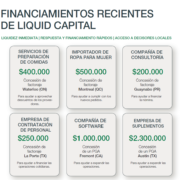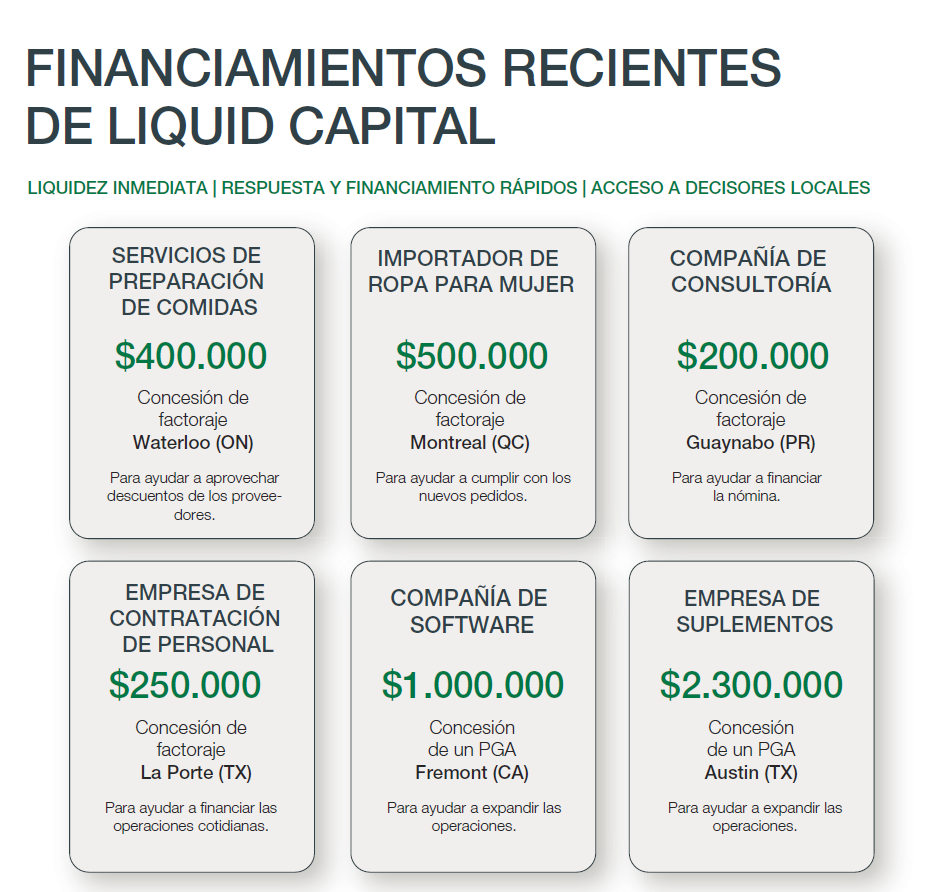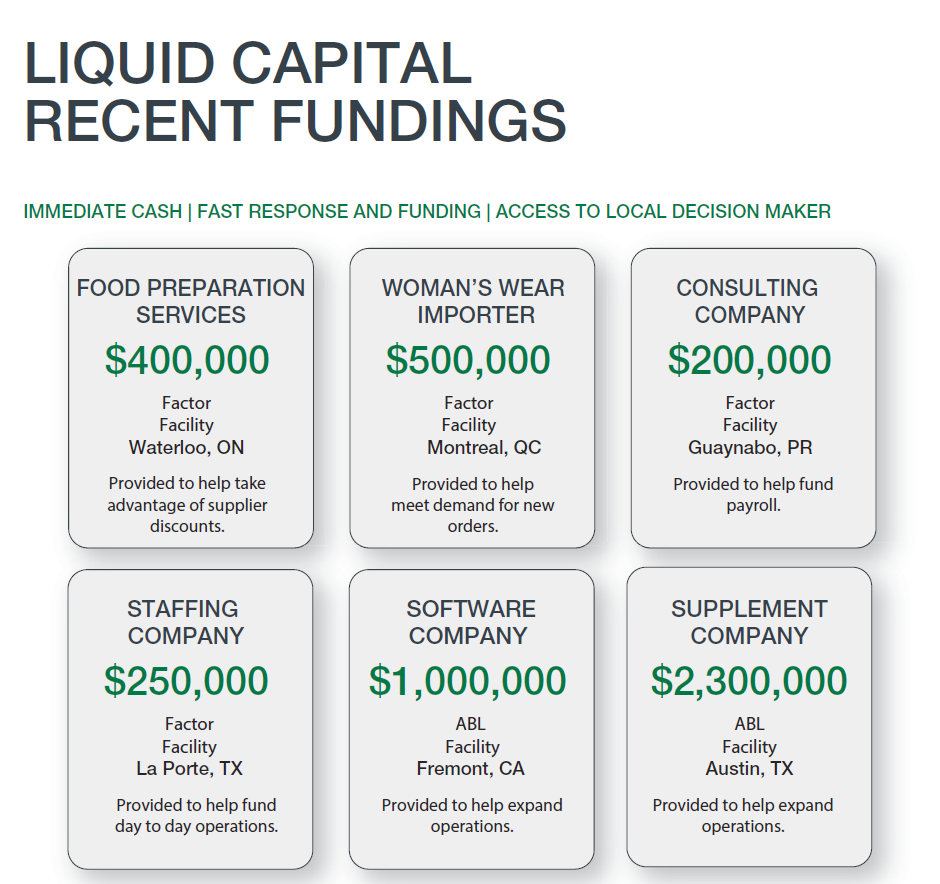Listado mensual: diciembre, 2017
El préstamo garantizado por activos y cómo encontrar el socio indicado
/en Blog/por Liquid Capital
Para muchas empresas, los préstamos garantizados por activos (PGA) pueden ser la solución perfecta cuando se ven cortas de capital circulante y que no llenan aún los requisitos para obtener un préstamo tradicional. La clave es encontrar el socio de financiamiento indicado que esté dispuesto a conocer su empresa, a comprender sus dificultades y a trabajar con usted para encontrar la solución óptima con la que obtendrá mayores beneficios para su empresa en expansión.
Encontrar al socio adecuado es una parte vital del proceso de financiamiento, sobre todo cuando usted cuenta con su experiencia, sus productos y sus conexiones. Nada obstaculiza más el funcionamiento de una empresa que la falta de capital circulante. Gracias a los préstamos garantizados por activos, usted dispondrá de capitales más grandes aceptando términos que maximizan el valor de sus activos disponibles. Obviamente, trabajar con un socio de confianza es crucial.
Contexto: ¿Quién debería considerar un préstamo garantizado por activos?
Los préstamos garantizados por activos (PGA) permiten que las compañías aprovechen sus cuentas por cobrar, su inventario y, en algunos casos, sus equipos e inmuebles con el fin de conseguir capital circulante. Las empresas que llenan los requisitos para dichos préstamos tienen por lo general una muy buena calificación crediticia y mantienen estados financieros completos con estrictos controles internos; estas tienden a ser empresas bien establecidas con una sólida trayectoria.
Artículo relacionado: Conozca los fundamentos del préstamo garantizado por activos aquí.
Con tantas opciones de financiamiento en el mercado ¿cómo saber cuál es la que le conviene a su empresa? A continuación, se presentan los tres principales factores que se deben considerar.
1. Encuentre un socio afín
Su experto en financiamiento por PGA debe asemejarse a un verdadero socio de su empresa: debe comprender su modelo comercial, las dificultades de su industria, las oportunidades y los procesos únicos que usted ha implantado. Un socio con mentalidad de empresario y experiencia personal como un dueño u operador de empresa puede también contribuir con una comprensión del punto del que usted proviene y el punto al que desea llegar.
Del mismo modo, busque socios de financiamiento que hayan reducido sus trámites y los complicados procesos de aprobación, ya que estos pueden retardar su capacidad de obtener flujo de caja cuando usted lo necesite. Sin embargo, tenga cuidado y asegúrese de que aun así sean fiables y de que tengan una buena reputación en el mercado.
Por último, un socio afín trabajará con usted a largo plazo y hará todo lo posible para obtener aún más por sus activos de garantía. Esto significa que sus activos le proporcionarán el mayor rendimiento en capital circulante.
2. Busque el valor de más que el simple «dinero»
Su socio PGA debe ser más que un simple emisor de cheque.
Considere varios aspectos de valor más allá del capital que dicho socio le proporciona. Con el PGA, los intereses son generalmente competitivos, pero depende del proveedor, de modo que es importante evaluar otros criterios que le muestren realmente con quien está tratando.
Busque socios de servicios que le permitan acceder a sus redes de contactos de referencia para extender sus relaciones comerciales. A menudo, este valioso factor duradero se pasa por alto, pero este puede representar un beneficio estratégico. Un socio de confianza también le permitirá obtener asesoría relacionada con las dificultades que afrontan las empresas en expansión y podrá darle consejos comerciales estratégicos y facilitarle benéficas herramientas a medida que su empresa crece. El acceso a una red de empresarios afines es de un valor inestimable para una empresa que afronta los desafíos de la emergencia y la expansión.
3. Trabaje con una persona y no con un simple software
La tecnología constituye un aspecto importante de los negocios modernos. No obstante, cuando se trata de una relación de financiamiento, se debe trabajar con una persona de verdad.
Sobre todo, acuda a representantes y expertos locales que le ayuden cuando usted tenga preguntas o dificultades. Busque una organización con garantías y evaluaciones de riego sólidas, y con buenas relaciones dentro de la industria. Su socio debe poder trabajar con usted para ofrecerle soluciones creativas a sus necesidades de financiamiento comercial.
Con los PGA, su empresa estará en manos de un socio de financiamiento que conseguirá grandes sumas de capital circulante; esto no se le puede dejar a un programa de software o a una página web que pregone rápidos financiamientos sin ninguna consulta estratégica.
How to Find the Right Asset-Based Loan Partner
/en Commercial Finance/por Liquid Capital
For many businesses, asset-based loans can be the perfect solution when they’re short on working capital but don’t currently qualify for a traditional loan. The key is finding the right funding partner that is willing to learn about your business, understand your challenges, and then work with you to find the optimal solution that will offer the most benefits to your growing business.
Finding that right partner is a vital part of the funding process, especially when you rely on their expertise, products, services and connections. Nothing can roadblock a company’s operations like lack of working capital. With asset-based loans, in particular, you’ll be accessing larger amounts of capital while agreeing on terms that maximize the value of your available assets. Obviously, working with a trusted partner is crucial.
Background: Who should consider an asset-based loan?
Asset-based loans (ABL) allow companies to leverage their accounts receivable, inventory, and in some cases, equipment and real estate to access working capital. Qualifying companies generally have a strong credit rating and maintain comprehensive financial reporting with strong internal controls — tending to be established businesses with a solid track record.
With many funding options in the market, how can you tell which one is right for your business? Below are three main factors to consider.
1. Find a like-minded partner
Your ABL funding expert should feel like a genuine partner in your business. They’ll need to understand your business model, industry challenges, opportunities, and any unique processes you have in place. A partner with an entrepreneurial mindset and personal experience as a business owner/operator could also add to their understanding of where you’re coming from and where you are going.
Also, look for funding partners who have cut their own red tape and complicated approval processes. These can slow down your ability to access cash flow when it’s needed — but be careful to ensure they are still credible and still have a strong reputation in the market.
Ultimately, a like-minded partner will work with you in the long-term and should go the extra mile to create more availability against eligible collateral. That means your assets will provide the biggest return for working capital.
2. Look for value beyond the “money”
Your ABL partner should be more than just a person that writes you a check.
Factor in various aspects of value beyond the capital they provide. With ABL, rates are generally competitive but on par with different vendors, so it’s important to assess other criteria that can show who you’re dealing with.
Look for service partners who will provide access to their referral networks that can extend your business relationships. This longer-term value is often overlooked but can be a strategic benefit. A trusted partner will also provide access to advice related to the struggles of a growing business, and they’ll be able to offer strategic business advice and beneficial tools as you grow the company. Their network along with access to like-minded entrepreneurs are invaluable to a business facing the challenges of growth and emergence.
3. Work with a person, not just a piece of software
Technology is an important aspect of modern business, but when it comes to a funding relationship, you should be working with a real person.
In particular, find local representation and experts who will be responsive when you have questions or challenges. Look for an organization with strong underwriting, risk assessment and good relationships within the industry. Your partner should also be able to work with you to offer creative solutions to your business funding needs.
With ABL, your company is going to be relying on the funding partner for large amounts of working capital, and this shouldn’t be trusted to a piece of software or website touting fast-funding without strategic consultation.
The 4 P’s of Outsourcing
/en Principal Posts/por Ernane Iung
Time is limited. I get that. You’d have to be a wizard with some kind of time-turning device to personally check all the boxes on an entrepreneur’s to-do list. And even if you could, why would you want to? This is a business, not a contest. Your objective should be to build the leanest, meanest, sustainable organization possible.
But cash is also limited, especially during the pre-launch phase, before you’ve issued and collected on your first invoice. What entrepreneurs need is a methodology for organizing to-dos, and for determining which are must dos, which should be outsourced, and which could be done at a later date, or not at all. My 4P method does that.
You may have heard of the Four “P”s of marketing: Product, Price, Place, and Promotion. Given my bias for action, my four Ps are verbs, not nouns, and represent a four-step process for successful outsourcing: Planning, Picking, Phasing In/Out, and Partnering.
Step 1 – Planning
In the first step we outline the basic structures you will need in your business for it to be functional. This is unique to every business, but there are some basic areas that are common to all – invoicing, selling, taxes, accounting, etc. Begin this “Planning” phase by listing all the bases that need to be covered in your business, for example:
- Prospecting
- Selling
- Invoicing
- Collections
- Accounting
- Bookkeeping
- Finances
- Payroll
- Procurement
- Industrial Design
- Product development
- Code writing
- Hiring
- Training
- Writing
- Publishing
- Marketing communications
- Digital marketing
- IT
- Delivery/Logistics
- Warehouse management
Your list will be unique for your company or industry. But you will know what to include because these are all things you’re going to have to deal with in YOUR business.
Step 2 – Picking
The next step is the fun one. Here you will put the above items in an EXCEL spreadsheet and “Pick” the jobs you want to do by putting your name next to them. You should base your decisions on the following criteria:
- What do you do best?
- What do you like to do?
- What do you not like to do?
- What could you pay someone else to do cheaper?
- And, what else could you do, in a pinch, if you had to?
I included the last one in recognition of the fact that resources are limited and you may need to do certain things you may not want to do in the best interest of your company, until you have enough cash coming in to hand off to someone else. Assign ownership to these tasks using three distinct labels:
Step 3 – Phasing in/out
Megatons of thrust are required for a rocket to break free of Earth’s atmosphere. But once the rocket is in orbit, the fuel tanks and similar dead weight are cast off so that the rocket can maneuver more nimbly. Similarly, there are processes required at the launch of a business that are no longer necessary once the business is up and running. The third “P” pertains to “Phasing” tasks in and out, and could also reasonably be called “Pruning.” For this step, add two more columns to your spreadsheet. Label the first column, “6 months,” and the second, “1 year.”
In these columns you will demarcate items you plan to bring in house, consolidate with other activities, or eliminate because they are no longer necessary. This is a discipline that even some of the world’s biggest companies struggle to master, but it critical if you want your business to remain competitive.
Step 4 – Partnering
The fourth and final P is Partnering. This is where you identify strategic third-party relationships that will add measurable value to your business by:
- Providing capabilities or services you would not otherwise be able to offer
- Filling a critical skills or talent gap
- Partnering with other small businesses to share the cost of non-core services and infrastructure
- Sharing office space, administrative personnel, Internet access, and IT infrastructure, with other businesses.
This is, by no means, a comprehensive list. Your list will reflect the needs and profile of your business.
By using the four Ps, you can plan to do only those things you like, you´re good at, and to which you add value within the realm of your company. You can identify processes you’d like to bring in-house, consolidate, or eliminate, and look for ways to share costs and resources with others through strategic and value-added partnerships. And you can outsource within the limitations of cash flow and budget.
3 incredible business gift guides
/en Biz Tips/por Vince Mancuso
If your holiday shopping list is making you nervous, especially when it comes to clients and colleagues, don’t worry. We’ve got you covered with gift ideas for even the most hard-to-impress business pros in your life.
Part of being an entrepreneur or SMB owner is an understanding that balancing work and life can be demanding. Even if your office closes for a few days, business doesn’t completely stop for the holidays. For many of us, it gets a lot busier. Here’s hoping that this handy gift guide makes your festive season flow a little smoother.
Here are our top picks from three of the best gift guides around. Click through further to see the full lists and peruse their expertly curated suggestions. Best of all, most of these items are available on Amazon with just a few clicks — perfect for those of us on a tight schedule.
1. Thirty Boring Gifts Everyone Secretly Wants by Mashable
The tech bloggers at Mashable really nail it with this list of essential items that will get used all year (as opposed to ending up in the garage after January). Take for example Smartwool Socks, an All Purpose Kitchen Knife, Rainbow Sharpies, a Fold Up Rain Jacket, and Noise Canceling Headphones. These make outstanding gifts for the kid in all of us.
2. Gizmodo’s Gadget Gift Guide
Comprised of “things we’re hoping to receive this season,” the tech experts from popular gadget blog Gizmodo assembled an incomparable guide for all the electronically inclined folks on your list.
Highlights include Outdoor Research Stormtracker Heated Gloves for cold weather outdoor enthusiasts, the quintessential Audio-Technica LP120 Professional Turntable for those looking to get serious about collecting vinyl, and the face-rejuvenating Clarisonic Mia 2 Facial Sonic Cleansing System.
3. Gifts for Entrepreneurs by celebrity Entrepreneur Tim Ferriss
Legendary angel investor, author, social media guru and podcaster Tim Ferriss shares his list of fantastic gift ideas for fast-paced individuals like himself.
Tim’s recommendations are broken down into helpful categories of under $25, under $50, and under $100. Highlights for us include the RAD Roller, which is amazing for rolling out tight muscles in the back, arms, and legs. The Sleep Master Sleep Mask is great for anyone who sleeps on planes or on irregular schedules. And finally the multipurpose casual/athletic shorts Ferriss swears by Myles Everyday Shorts.
Bonus: Other notable gift guides
These include one from The Atlantic for the impossible-to-buy-for, which they crowd-sourced from real readers. Refinery 29 has another very fun interactive gift guide for Moms, Dads, significant others and even your ‘work spouse.’ Generate a custom selection of gifts based on traits like chill, type A, early adopter and fancy.
Tres increíbles guías de regalos comerciales
/en Blog/por Vince Mancuso
Si su lista de compras navideñas lo pone nervioso, especialmente cuando se trata de sus clientes y colegas, no se preocupe. Le tenemos una cantidad de ideas incluso para el empresario más difícil de impresionar en su vida.
Parte de ser empresario o dueño de una PME es comprender que alcanzar el equilibrio entre trabajo y vida personal puede ser extenuante. Aun si su oficina cierra por unos días, los negocios no se detienen totalmente durante las festividades. Para muchos de nosotros, es un período incluso mucho más ocupado. Aquí le presentamos esta – esperamos útil – guía de regalos que hará que su temporada navideña sea un poco más suave.
A continuación, encontrará nuestra selección de tres de las mejores guías de regalos que existen. Haga clic para ver con detenimiento las listas completas de sugerencias recopiladas por expertos. Lo mejor de todo es que estos artículos se pueden comprar por Amazon con tan solo unos pocos clics — perfecto para aquellos quienes tenemos un horario apretado.
1. Treinta regalos aburridos que todos desean secretamente, por Mashable
Los blogueros en tecnologías de Mashable realmente dieron en el clavo con esta lista de artículos esenciales para utilizar todo el año (en lugar de terminar arrumados en el garaje después de enero). Por ejemplo unas medias de lana Smartwool, un cuchillo para cocina multiuso, unos marcadores multicolor Sharpie, un impermeable fácil de doblar y unos auriculares de cancelación de ruidos. Estos son obsequios que sobresalen y que alegran al niño que todos llevamos dentro.
2. Guía de aparatos para regalar de Gizmodo
Compuesta por «las cosas que esperamos recibir esta navidad», esta incomparable guía elaborada por los expertos en tecnologías del popular blog sobre aparatos de moda, Gizmodo, es la precisa para aquellos empresarios de su lista que se inclinan por la electrónica.
Algunos artículos que se destacan son los guantes calentadores a prueba de intemperies para los amantes de las actividades al aire libre en clima frío, el tocadiscos profesional por excelencia Audio-Technica LP120 para aquellos que buscan coleccionar en serio discos de vinilo y el rejuvenecedor de rostro Clarisonic Mia 2 Facial Sonic Cleansing System.
3. Regalos para empresarios del célebre empresario Tim Ferriss
Ángel inversionista legendario, autor, gurú de las redes sociales y creador de podcasts, Tim Ferriss comparte su lista de ideas fantásticas de regalos para personas aceleradas como él.
Las recomendaciones de Tim están clasificadas de forma práctica por precios: menos de $25, menos de $50 y menos de $100. Las sugerencias que destacamos son el RAD Roller, que permite masajear los músculos de la espalda, brazos y piernas. La máscara para dormir Sleep Master, estupenda para todos aquellos que deben dormir en el avión o que tienen horarios irregulares. Y por último, los pantalones cortos atléticos/casuales multiuso en los que Ferriss tiene una fe ciega: los pantalones cortos de uso diario de la marca Myles.
Otras guías de regalos que se destacan incluyen una lista de The Atlantic para aquellas personas a las que es imposible comprarles algo, la cual fue recopilada gracias a una colaboración masiva y cuyas ideas vienen de verdaderos lectores. Refinery 29 tiene una muy simpática guía interactiva de regalos para mamás, papás, seres queridos e incluso para su «cónyuge de trabajo». Genere una selección personalizada de regalos basada en rasgos tales como relajado, tipo A, usuario pionero y sofisticado.
Conéctese con nosotros
1-844-228-0800
Oficina Principal en Canadá
Liquid Capital Enterprises Corp.
5075 Yonge Street, Ste. 700
Toronto, ON M2N 6C6
Oficina Principal en los Estados Unidos
Liquid Capital Enterprises Corp.
921 West New Hope Drive,
Suite 702
Cedar Park, TX 78613-6786
Últimas publicaciones
 5 Gifts for Your 2026 Success: Insights from Leading Commercial Loan Brokersdiciembre 4, 2025 - 4:28 pm
5 Gifts for Your 2026 Success: Insights from Leading Commercial Loan Brokersdiciembre 4, 2025 - 4:28 pm The Thanksgiving-to-Christmas Dilemma: White Elephants and Chocolate Turtles or Factor-Fueled Growth Plans?noviembre 13, 2025 - 8:07 pm
The Thanksgiving-to-Christmas Dilemma: White Elephants and Chocolate Turtles or Factor-Fueled Growth Plans?noviembre 13, 2025 - 8:07 pm










